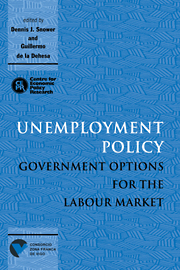Book contents
- Frontmatter
- Contents
- List of figures
- List of tables
- Preface
- Acknowledgements
- List of conference participants
- 1 Introduction
- PART ONE GENERAL POLICY ISSUES
- PART TWO DEMAND MANAGEMENT AND SUPPLY-SIDE POLICY
- PART THREE SUBSIDISING EMPLOYMENT AND TRAINING
- PART FOUR LABOUR MARKET REGULATIONS
- PART FIVE POLICY, JOB REALLOCATION AND THE UNEMPLOYMENT–PRODUCTIVITY RELATION
- PART SIX COMPARING UNEMPLOYMENT POLICIES
- 16 Unemployment in the OECD and its remedies
- Discussion
- Discussion
- 17 The unemployment and welfare effects of labour market policy: a comparison of the USA and the UK
- Discussion
- Discussion
- Index
Discussion
Published online by Cambridge University Press: 07 September 2010
- Frontmatter
- Contents
- List of figures
- List of tables
- Preface
- Acknowledgements
- List of conference participants
- 1 Introduction
- PART ONE GENERAL POLICY ISSUES
- PART TWO DEMAND MANAGEMENT AND SUPPLY-SIDE POLICY
- PART THREE SUBSIDISING EMPLOYMENT AND TRAINING
- PART FOUR LABOUR MARKET REGULATIONS
- PART FIVE POLICY, JOB REALLOCATION AND THE UNEMPLOYMENT–PRODUCTIVITY RELATION
- PART SIX COMPARING UNEMPLOYMENT POLICIES
- 16 Unemployment in the OECD and its remedies
- Discussion
- Discussion
- 17 The unemployment and welfare effects of labour market policy: a comparison of the USA and the UK
- Discussion
- Discussion
- Index
Summary
Chapter 17 is part of a recent and fast-growing literature based on the Mortensen and Pissarides (hereafter MP) extension of standard matching models. Since separations and hires occur simultaneously in reality, models of the labour market should allow for events affecting individual job–worker pairs rather than the aggregate economy. In previous models, the probability that such ‘idiosyncratic’ events would lead to match dissolution was taken to be exogenous, and no explanation could be provided for the variable intensity of labour reallocation over time and across labour markets; in the MP model, conversely, a realistic stochastic process for an individual job's productivity lets separation be the endogenous consequence of economic decisions, and gives the labour market some freedom of choice in determining the intensity of labour reallocation.
I was asked by Dennis Snower to discuss this growing literature's seminal paper, now published as Mortensen and Pissarides (1994). I am indeed very pleased to see that seminal idea followed up very much along the lines I thought would be fruitful. When extended to allow for realistic labour market institutions, the MP model provides a very elegant setting for addressing a number of important questions, and chapter 17 proves intriguing answers to some of them.
In chapter 17 and in other papers, Millard and Mortensen analyse the determinants of observed labour market outcomes across different institutional environments. They add to the basic framework a number of parameters representing real-life policy and institutions, and use US and UK evidence to carefully calibrate their effect on equilibrium unemployment and relocation intensity.
- Type
- Chapter
- Information
- Unemployment PolicyGovernment Options for the Labour Market, pp. 572 - 575Publisher: Cambridge University PressPrint publication year: 1997
- 1
- Cited by



